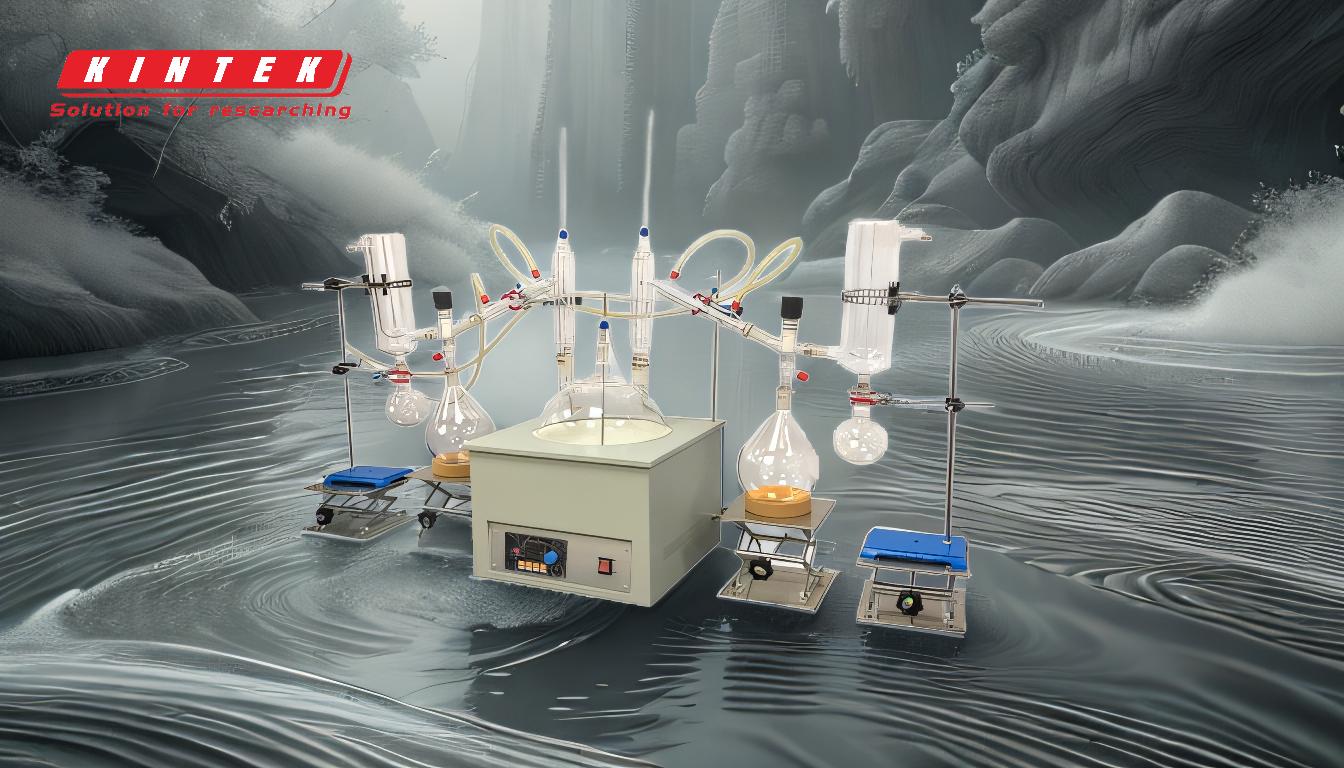A short path distillation unit is a specialized apparatus used for the purification and separation of heat-sensitive compounds, particularly those that are unstable at high temperatures. It operates under reduced pressure (vacuum), allowing for lower boiling temperatures and minimizing thermal stress on the distilled product. The process involves heating a substance in a boiling flask, vaporizing the desired components, and condensing them after traveling a short distance. This method is highly efficient for separating compounds with different boiling points, such as terpenes, flavonoids, and essential oils, while preserving their integrity. The unit typically includes glassware, a heating mantle, a vacuum pump, and cooling systems to ensure precise control over the distillation process.
Key Points Explained:

-
Definition and Purpose of Short Path Distillation:
- Short path distillation, also known as molecular distillation, is a thermal separation process designed for heat-sensitive products.
- It is used to purify small quantities of compounds that are unstable at high temperatures, ensuring minimal thermal degradation.
- The process operates under a vacuum (0.001 to 1 mbar), which lowers boiling points and reduces thermal stress on the distilled material.
-
Key Components of a Short Path Distillation Unit:
- Glassware: Includes a boiling flask, condenser, and collection flasks, often made of thick glass for durability and protection.
- Heating System: A heating mantle or similar device heats the substance to its boiling point under controlled conditions.
- Vacuum Pump: Creates the necessary vacuum environment to lower boiling points and facilitate vaporization.
- Cooling System: A condenser or chiller cools the vaporized compounds, causing them to re-condense into liquid form.
- Wiper Elements: Metal or graphite wipers ensure even heating and prevent material from sticking to the walls of the apparatus.
- Vacuum Trap: Often filled with dry ice and alcohol to condense and collect volatile compounds.
-
How Short Path Distillation Works:
- The substance is placed in a boiling flask and heated under vacuum conditions.
- The vacuum lowers the boiling point, allowing the desired compounds to vaporize at lower temperatures.
- The vapor travels a short distance (a few inches) through a distillation head or condenser.
- The vapor is then cooled and re-condensed into a highly pure liquid, which is collected in separate flasks.
- Unwanted compounds remain in the boiling flask or are trapped as waste.
-
Advantages of Short Path Distillation:
- Gentle Processing: The low temperatures and short residence time minimize thermal stress, making it ideal for heat-sensitive materials.
- High Purity: The short travel distance reduces contamination and ensures a highly pure final product.
- Efficiency: The process is efficient for separating compounds with close boiling points, such as terpenes and flavonoids.
- Scalability: Suitable for both small-scale laboratory use and larger industrial applications.
-
Applications of Short Path Distillation:
- Essential Oil Purification: Used to separate and purify terpenes, flavonoids, and other volatile compounds from essential oils.
- Chemical Refinement: Effective for removing impurities from delicate chemicals and pharmaceuticals.
- Cannabis and Hemp Processing: Commonly used in the cannabis industry to isolate cannabinoids like CBD and THC.
- Food and Flavor Industry: Applied in the extraction and purification of flavor compounds.
-
Considerations for Equipment Purchasers:
- Material Quality: Ensure the glassware is made of thick, durable glass to withstand vacuum pressures and thermal stress.
- Vacuum Efficiency: Choose a vacuum pump capable of achieving the required pressure levels (0.001 to 1 mbar).
- Cooling Capacity: Select a cooling system (chiller or condenser) that can handle the volume and type of compounds being distilled.
- Ease of Assembly: Look for modular systems that are easy to set up and disassemble for cleaning and maintenance.
- Safety Features: Ensure the unit includes safety components like vacuum traps and temperature controls to prevent accidents.
By understanding these key points, purchasers can make informed decisions when selecting a short path distillation unit, ensuring it meets their specific needs for purity, efficiency, and safety.
Summary Table:
| Aspect | Details |
|---|---|
| Purpose | Purifies heat-sensitive compounds under vacuum to minimize thermal stress. |
| Key Components | Glassware, heating mantle, vacuum pump, cooling system, wiper elements. |
| Process | Heats substance under vacuum, vaporizes compounds, condenses for collection. |
| Advantages | Gentle processing, high purity, efficiency, and scalability. |
| Applications | Essential oils, chemical refinement, cannabis processing, flavor compounds. |
| Purchasing Considerations | Material quality, vacuum efficiency, cooling capacity, safety features. |
Ready to enhance your purification process? Contact us today to find the perfect short path distillation unit for your needs!











